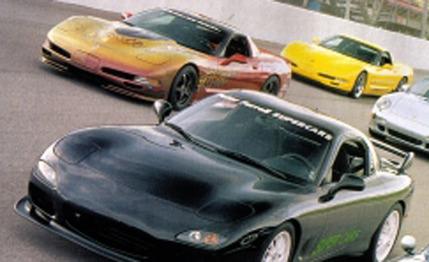
 Comparison Tests
Comparison Tests
The price of innovation is often frustration, and we definitely proved that adage in the course of conducting the megapower tuner test you have before you. From mechanical breakdowns to 10-ton loads of gravel blocking our way, we encountered every problem imaginable. Before describing the gory details, we'll explain the object of our exercise.
For some time, we've been searching for ways beyond our conventional battery of tests to evaluate very high-powered modified cars. Three years ago, we tried a 0-to-150-mph-to-0 test (C/D, August 1998) that measured standing-start acceleration, high-speed acceleration, and 150-to-0-mph braking.
That test, however, did not include handling. This time around, we resolved to incorporate enough twisty bits to gauge a car's cornering abilities, in addition to the 0-to-150-to-0 test.
We found the perfect venue in our backyard — Michigan International Speedway, where the Michigan 500 CART race and two Winston Cup races, the Kmart 400 and the Pepsi 400, are run. It not only sports a 2.0-mile tri-oval but also has an infield road-racing loop.
After a morning spent reconnoitering the oval and the road course, we developed a promising configuration. We would start on the wide apron at the south end of the back straight. Unlike the straight itself, which is tilted at five degrees, this apron is flat, providing an ideal launching pad for these powerful cars.
After the start, the car would blast down the 2200-foot straightaway to a point just before Turn Three, where our driver would brake hard, make a sharp left turn, and roar onto the infield road course. After 0.86 mile of sharp left and right turns, each car would return to the back straightaway, at the point where it had left, and would then accelerate up to 150 mph and brake to a full stop. The cars would be ranked by their total elapsed time over the course, about two miles in all. And thanks to the sophisticated GPS-based Racelogic VBOX instrumentation we would be using, we would have segment times for the quarter-mile, the road course, the 100-to-150-mph acceleration, and the 150-mph-to-standstill stop.
Since our goal was to identify the street car with the highest performance in the land, we beat the bushes for the most muscular tuned production and kit cars capable of outrageous speed, and for bucks-up exotics in the McLaren F1 and Ferrari F50 realm.
Alas, we found that exotic-car owners were either fearful that we would break their rare and pricey machines or concerned that our story would draw unwanted official attention to their vehicles, which are in some cases imported with questionable documentation.
Still, we rounded up an excellent variety of home-grown speedsters. There were a lot of rules, but the two main ones were this: Cars must run on pump gas and be shod with DOT-approved tires with at least 5/32nd of an inch of tread. An entrant could drive his car during the tests, or bring a special driver, or rely on our man, technical editor Larry Webster.
As test day approached, the tragedies began. Chuck Beck's light and powerful Lister Corvette replica blew its engine after he had hastily removed the small-block Chevy's 13.0:1-compression pistons to meet our pump-gas rule. Next, Warren Mosler's MT900 was waylaid by ominous metal filings in its oil pan, followed soon after by John Hennessey's twin-turbo Venom 800 being besieged by electrical gremlins. He substituted a modified Corvette. Then, the vehicle transporting the Corvette to Michigan was involved in a crash, and Hennessey couldn't make the date. Finally, the Spectra Works Corvette fell victim to the illness of a key staffer two days before our test.
On the Monday morning of the test, we were down to six cars. Day one was set aside for a ride and drive in the country, with lots of time for photography. Unfortunately, we were greeted by a heavy rainstorm. Soon after the rain cleared, things started going wrong. The left front wheel promptly fell off the Factory Five Racing coupe. Then the RENNtech CLK60SC fried its engine's mass-airflow sensor. Meanwhile, the Peter Farrell Supercars RX-7 suffered at least three malfunctions that sidelined it for most of the afternoon. After hours of ministrations, however, all these cars were running, plus an AutoThority 911 Turbo and a pair of Corvettes from Mallett and Lingenfelter.
That evening, as we arrived at MIS for a group photo session, we were greeted by two 10-ton piles of gravel smack in the middle of our road course, a byproduct of renovation work. After we stopped hyperventilating, we were assured the gravel would be removed and the track scrubbed by the next morning.
Indeed, all was clear on Tuesday morning, but once running, we found that the back straight was not long enough for most of the cars to get up to 150 mph because they were running against a prevailing 15-mph head wind on this humid 90-degree day. Then we ran into teething troubles with the VBOX power supply in the Factory Five car. Luckily, Julian Thomas, the president of the British company that makes the device, was on hand to help, but we still fiddled for an hour before we sorted out the trouble. Then the RENNtech CLK60SC's engine computer collapsed, and the Mallett Corvette started leaking compression.
One by one, the crews that came with the cars, and our tech staff, worked through the problems. We used the maximum speed the cars were able to achieve on the course as the measure of their finishing order. Chuck Mallett coaxed three runs from his car and managed to remain in the competition. At the end of the day, five cars were still running. To see how they did, read on.